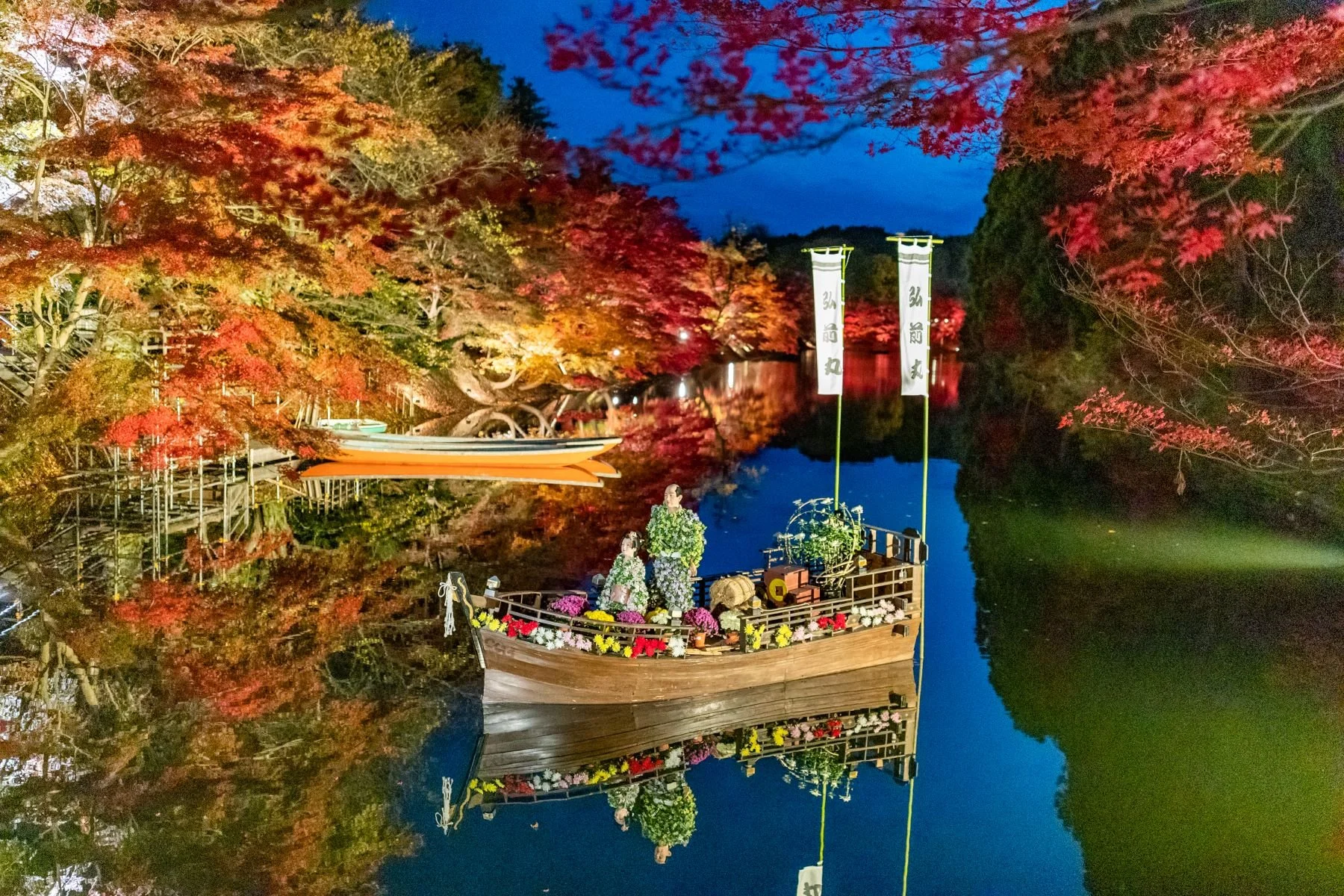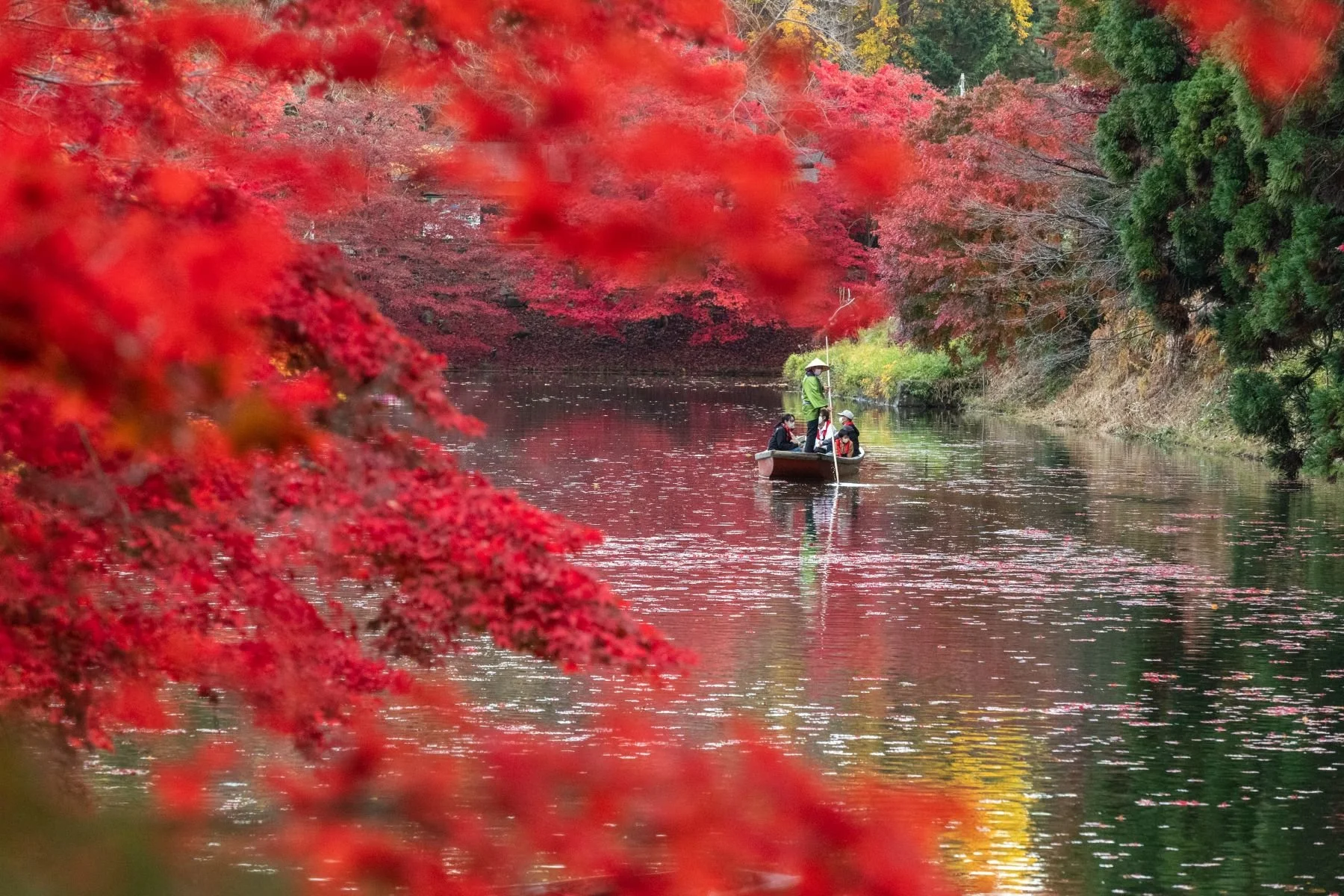An unforgettable journey into the northern mountains and beyond: experience Nikko, Fukushima and Aomori in Autumn.
Enjoy Tohoku in 7 days and 6 nights in the comfort of TokudAw’s private charter
Japan's magnificent north eastern region is often considered one of its wildest and most scenic, thanks in part to a grandiose topography replete with natural wonders and a slightly colder climate. It is characterised by the towering peaks and highland plains of Japan's longest mountain range - the Ōu Mountains - hot springs, volcanic lakes and a rich, colourful history. For those familiar with Edo-era poet Matsuo Bashō's famous poem, 'The Narrow Road to the Deep North', this is the region to which he ventured. As this private tour unfolds you'll travel from Tokyo all the way up to Honshu's northern coast and you'll encounter many of the locations Basho visited, no doubt seized by a similar wanderlust to the poet himself!
Autumn, one of the most beautiful seasons in Japan. Image Credit: Shutterstock
Day 1: Tokyo to Nikko
The road from Tokyo to Nikko climbs into the first foothills of the Ashio Mountains, a majestic region of rugged peaks, plateaus and waterfalls, richly decked in autumn colours. As you pass into the higher elevations of the Nikko region, you'll travel along the spectacular Tochigi Irohazaka, a dramatically winding road that leads up onto the Akechidaira Plateau, where you can look down on the Irohazaka itself winding up through the red and golden hues of the autumn forests that carpet the mountainside.
Nikko city itself has a long history as a centre of Shinto and Buddhism and is home to a profusion of temples and shrines, the Tokugawa Mausoleum one of the most famous among them. This combination of spectacular natural scenery, from lofty peaks to steaming hot springs, traditional architecture and a strong connection to Japan's spiritual history make Nikko the ideal place to begin your journey into the north.
View of Irohazaka in autumn hues. Image Credit: hanahana01
Day 2: Nikko – Aizu Wakamatsu – Goshikinuma Ponds--Bandai Azuma Skyline–Fukushima
Driving north through the mountains you'll reach the historic city of Aizu Wakamatsu, a former stronghold of the Aizu clan. Its samurai roots reach almost to modernity, as the castle saw battle as recently as 1868 when it fell to the Emperor's forces during the Battle of Aizu, eventually making way for the Meiji Restoration. The city is also home to one of Japan's oldest sake breweries, and thanks to the quality of the region's water and rice, this is considered some of the best sake in Japan.
If you want to travel further back in time and experience Japan as it was in the Edo-era, Ouchijuku is one of Japan's best examples of a historical border town. The buildings here are fully restored to be as they were when this was an important stopping point on the Aizu Nishi Kaidō – a busy road for travellers on foot between Aizu castle and Edo itself.
Following a journey through Japan's past, there is no better place for a state of peaceful reflection than the Goshikinuma Ponds. These volcanic pools are full of minerals that make their waters an array of brilliant hues, from emerald greens to turquoise blues, while the surrounding landscape of mist shrouded mountains and lush forests gives the region a magical, otherworldly atmosphere.
For the last stretch of the journey to Fukushima, you'll travel along the famous Bandai Azuma Skyline Roadway, a high road through the mountains that provides spectacular views over the region. In autumn, it's a sea of fiery red, yellow and orange forests rising and falling through the mountains and valleys, and look out for the crater of Mt. Azuma-Kofuji, it's an unforgettable sight.
Left: Bandai Azuma Skyline, Right: Goshikinuma Ponds. Image credit: Fukushima City Tourist Information and Shutterstock
Day 3: Fukushima– Matsushima – Hachimantai Aspite Line – Lake Towada
From Fukushima, you'll travel north to one of the region's natural marvels, the pine islands of Matsushima bay. These 260 islands are all that remain of prehistoric hills which sank into the bay, leaving only their highest parts above water.
Northwards from here you'll soon find yourself among the snows that surround Mount Hachimantai, and travelling along the famous Hachimantai Aspite Line, a road that cuts right through the deep snow drifts that blanket this part of Honshu. This magical roadway is the perfect passage to one of Tohoku's most spectacular sights, the truly otherworldly Lake Towada. The largest of Honshu's crater lakes, this exquisitely beautiful lake shines a brilliant blue as a result of its enormous depth and fills the caldera of an active volcano, although its last eruption was in 915 AD, so don't worry!
Lake Towada. Image Credit: Shutterstock
Day 4: Lake Towada- Oirase Stream – Jogakura Bridge – Hakkoda Ropeway – Hirosaki Apple Park – Hirosaki
It's difficult to overstate the beauty of the landscape around Lake Towada, and Oirase Stream, which flows out of the lake and down through the forested slopes of the Oirase Gorge is at its most spectacular in autumn. The trees in brilliant yellows, reds and oranges are interspersed with more than a dozen waterfalls which flow into the stream itself.
For an incredible vantage, climb up to the Jogakura Ohashi bridge which soars out of the burnished golds and oranges of the autumnal forests of the Towada-Hachimantai National Park, 400 feet over Jōgakura Creek, giving visitors some of the best views of the region's beautiful natural scenery.
Next you'll leave the ground entirely, and take in the views over Towada Hachimantai National Park from the Hakkoda Ropeway. Ride high above the autumn forests to the peak of Mt. Tamoyachidake, where you look out over Tsugaru Peninsula, Shimokita Peninsula and Mt. Iwaki, as well as the Hakkoda Mountains.
Hirosaki is the largest producer of apples in Japan, and has a dedicated Apple Park for visitors to join in with the harvest through the autumn months! The vast farm of fruiting apple trees is itself a sight to behold, but you can also learn more about the history and process of apple cultivation, visit the nearby cider brewery, and pick some apples of your own. The castle city of Hirosaki itself is famous as a centre of culture. Visitors should make time to visit the faithfully preserved samurai residences in the city's samurai district, just north of the castle itself.
From Top left to bottom right: 1. Oirase Gorge, Jogakura Ohashi bridge, Hakkodasan Ropeway, Crysanthemum and Momiji Festival at Hirosaki Park, Delicious Apples at Hirosaki. Image Credit: Shutterstock and Amazing Aomori.
Day 5: Hirosaki – Sakata – Mt Haguro
From Hirosaki you'll begin the journey south, stopping at Sakata Port, to sample freshly caught seafood, then moving on to the majestic five storey pagoda at Mt. Haguro. This pagoda dates back to the 14th century but its predecessor was even older, from the 10th century, though it was sadly destroyed by fire. Standing here among the ancient cedars of Mt. Haguro, you can almost feel the weight of the centuries that have passed around this relic of Japan's distant past.
There's time for reflection, and then there's time for eating. Tsuruoka is a UNESCO Creative City of Gastronomy, and preserves many ancient methods, seed varieties and customs for cultivating food, while introducing new and innovative ways of preparing it. This is an experience no food lover will want to miss.
Day 6: Tsuruoka – Sasagawa Nagare Coastal Line –Minamiuonuma
On this part of the journey south you'll travel past the magnificent rock formations and rugged cliffs carved out by the Sea of Japan over the centuries, punctuated with white sandy beaches and the clear blue sea itself as we make our way to Minamiuonuma, and the beautiful Satoyama Jujo.
Satoyama Jujo is a design hotel which offers visitors one of the very best ryokan experiences available. Secluded among three mountain ranges and surrounded by woodlands, the sense of having returned to nature is profoundly restful. Here you can enjoy onsen in a luxurious setting, before sampling the locally sourced organic menu.
Day 7: Minamiuonuma – Kiyotsu Gorge – Naeba Dragondola –Tokyo
On the final day of the journey you'll experience a true wonder. Kiyotsu Gorge is one of Japan's Three Great Gorges, and its steep, rugged sides and powerful river present a scene of spectacular natural drama, which you can observe from its atmospheric viewing platform.
For your final time among the autumn colours, board the 5,481m long gondola to the summit of Mt. Naeba and ride high above the mountain forests. Be sure to look out for wild monkeys, and the blue waters of Tashiro Lake.
Left: Kiyotsu Gorge, Right: View from the Dragondola. Image Credit: Travel Daily Photo and Niigata Prefectural Tourist Association.
On your return to Tokyo, as you reflect on all the wonders of Tohoku – its historic temples, mountain lakes and the fiery reds and golds of the autumn forests – remember that your experience has been shared by some of Japan's greatest artists and writers over the centuries, along with the innumerable nameless travellers who have made similar journeys in the name of pilgrimage or necessity. We hope that our visitors carry this sense with them, and treasure what they've seen as much as we treasure helping them to see it.
To enquire about this tour, please contact here.













